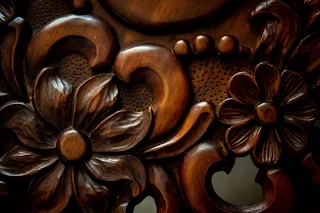Flatwood drilling types
The types of drilling on natural wood are divided into the traditional works as follows:
Punching and piercing The craftsman unloads the wood in the form of different panels that represent drawings of certain plants and flowers, animals and birds, or verses and wisdom, which is greatly concerned with their manufacture, which gives his products an appearance of precision that attracts attention.
Woodturning This craft depends on the manufacturer's ability to adapt wooden pieces by means of a manual lathe, thus producing pastry moulds, dice, chess, hookah heads, wooden chair frames, and others... It has recently switched to automated production. A special market was built for this craft in Damascus, the Kharatine Market.
Vaccination
Main article: Wood inlay (Marquette)
It depends on highlighting the symmetry in the drawn shapes by inlaying wood with various materials such as mother-of-pearl, bone, tin, copper and even silver, by engraving precise lines representing the required drawings, and then filling them with the required material. In this way, the craftsmen produce mosaic boxes, jewellery boxes, luxurious desks, tables, chairs, and tables. picture frames, and more.
Downloading on wood was quoted from mosaic works in the Byzantine era, different from the art of engraving, and Damascus knew its revival nearly a century ago when the craftsman George Bitar saw the masterpieces of mosaics in the Umayyad Mosque and quoted their idea trying to apply it to wood with mosaic. Or bone or mother-of-pearl in colours other than the colour of the carved wood, so the delicate geometric decorations and cursive inscriptions appear in the perforated bone material or the shell material with an attractive appearance.
Types of stereoscopic drilling
The flat relief engraving, in which the height of the engraved decorations reaches about 5 mm, is often found in the design of Islamic medallions and engravings.
The problematic excavation, in which the height of the decorations and figures engraved on the floor increases by more than half 0.5 cm and reaches about 7 cm in the Roman pits, provided that the floors in the figure are all equal and of the same depth.
Stereoscopic relief is similar to the problematic excavation, but it is more prominent and deep in the floors, which must be equal in one depth as well. Organisms.
Hollow drilling, which is drilling for hollow formations with a jigsaw and drilled at the same time, provided that its units hold together, and it is used in the work of precious frames. The empty chandeliers are used in the official halls. In general, drawings of animals abound in this style, such as deer, horses, lions, and predatory beasts, but their shapes are incomplete. For example, you see the form of the heads of two horses, but they are joined together in the form of a searchlight lily in a symmetrical decorative position.
Muqarnas is a type of decoration developed by the Arabs, and it became a feature of their art, and it has multiple images, some of which resemble limestone sediments hanging from some caves, and some resemble ant nests or beehives. In buildings distinguished by their domes. Currently, this art is limited to decorations that can be suspended from the ceilings, such as lighting centres and places for hanging chandeliers, the sides of large comfortable seats, the edges of tables and tables, or windowsills fixed in the walls and others. The Syrian Arabs inherited this art from those who preceded them from other nations, and they developed a lot in it until it became as it is in terms of innovation and creativity.
The sunken engraving is unlike the prominent pits of the previous types, in which the decorations are carved inward while leaving the floors as they are without engraving or engraving. The ancient Egyptians resorted to using them frequently in temples and tombs with little light to help the shadows clear and to live long.
Stereoscopic drilling, which is the most accurate type of drilling, includes drilling on blocks with the intention of forming and embedding them.
